Native plants don’t know anything about state lines—they grow in distinct communities based on climate, as shown on this map of the continental U.S. However, within each zone there are numerous microclimates as well—for example, the central prairies and plains province includes shortgrass prairie in the drier west and tallgrass prairie in the moister east. So when making selections from this plant list, determine your zone, then select plants from your zone that are adapted to drier conditions for the hottest part of your garden and that need more water for the areas where the soil naturally stays moist.
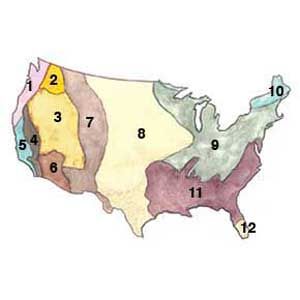
Native Plant Climate Zone Map
1. Northern Pacific Coastal/Cascade Mountain Forests
2. Palouse
3. Great Basin Desert
4. Sierran Foothills/Alpine Vegetation
5. California Grasslands, Chaparral, and Woodland
6. Mojave and Sonoran Deserts
7. Rocky Mountain Forests/Alpine Vegetation
8. Central Prairies and Plains
9. Eastern Deciduous Forests
10. Boreal Forests
11. Coastal Plain Forests
12. Tropical
1. North Pacific Coastal/Cascade Mountain Forests
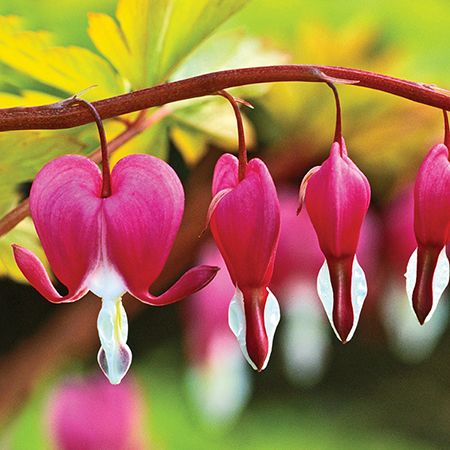
Shrubs:
Indian plum Oemleria cerasiformis: Very early bloomer. Fruit draws birds. Sun or shade. Slightly dry to moist. 15 feet.
Tall Oregon grape Mahonia (Berberis) aquifolium: Holly-shape leaves. Edible blue fruit. Sun or shade. Little to moderate water. 10 feet.
Red flowering currant Ribes sanguineum: Early pink flowers draw hummingbirds. Sun or shade. Dry soil. 12 feet.
Red osier dogwood Cornus stolonifera (sericea): Prized for winter twig color. Berries draw birds. Sun. Dry to wet. 15 feet.
Pacific Nine Bark Physocarpus capitatus: Interesting bark and seeds in winter. Sun to part shade. Moist to moderate soil. 12 feet.
Wildflowers:
Western columbine Aquilegia formosa: Red and yellow flowers draw hummingbirds. Sun or partial shade. Dry to moist. 3 feet.
Bleeding heart Dicentra formosa: Pink, heart-shape flowers. Shade to partial shade. Dry soil. 1½ feet.
Piggyback plant Tolmiea menziesii : Grows new leaves on top of old. Shade. Moist. 1 foot.
Ferns:
Deer fern Blechnum spicant: Unusual form, with erect fertile fronds and low sterile fronds. Dry shade or moist sun. 2½ feet.
Western sword Fern Polystichum munitum: Lance-shape fronds. Sun or shade. Moist or dry. 4 feet.
Resource:
Washington Native Plant Society
2. Palouse
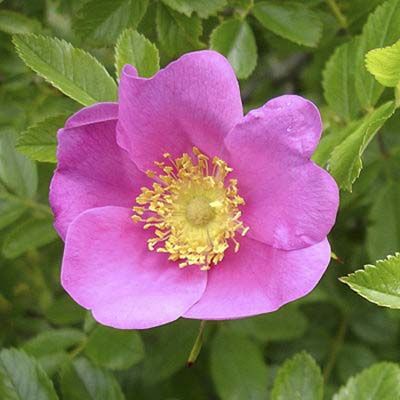
Grasses:
Bluebunch wheatgrass Agropyron spicatum: Blue-green leaves. Compact seed heads. Sun. Dry. 3 feet.
Idaho fescue Festuca idahoensis: Deep green or blue-green. Feathery seed heads. Sun to partial shade. Medium moisture. 2 feet.
Shrubs:
Serviceberry Amelanchier anifolia: Showy white flowers. Purple fruit draws birds. Sun to partial shade. Medium moisture. 20 feet
Nootka rose Rosa nutkana: Pink flowers up to 2 inches wide. Sun. Dry or moist with good drainage. 9 feet.
Black hawthorn Crataegus douglasii: Birds nest in tangled, thorny branches. Sun or shade. Moist. 15 feet
Wildflowers:
Western yarrow Achillea millefolium: Aromatic. White flowers. Sun to partial shade. Moderate water. 3 feet.
Blanketflower Gaillardia aristata: Red and yellow daisy-like flowers spring to fall. Sun. Moderate water. 2 feet.
Little sunflower Helianthella uniflora: Sunflower-type yellow blossoms in June. Sun to partial shade. Dry. 2 feet.
Lewis flax Linum lewisii: Delicate blue or purple flowers. Sun. Dry. 2 feet.
Prairie smoke Geum triflorum: Rose flowers. Feathery pink seed heads. Sun. Dry to moderate water. 6 inches.
Resources:
3. Great Basin Desert
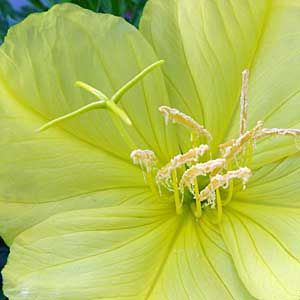
Grasses:
Alkali sacaton grass Sporobolus airoides: Medium-green leaves. Forms clumps. Sun. Dry. 3 feet.
Blue grama Bouteloua gracilis: Gray-green leaves. Forms clumps. Sun. Dry to medium moisture. 1 foot.
Indian ricegrass Achnatherum hymenoides: Airy and open clumps. Sun. Dry. 3 feet
Shrubs:
Oakleaf sumac Rhus trilobata: Showy fall foliage. Orange-red fruit draws birds. Sun to partial shade. Dry. 6 feet.
Apache plume Fallugia paradoxa: White flowers resemble wild roses. Plume-like seed heads. Sun. Dry. 6 feet.
Utah serviceberry Amelanchier utahensis White flowers. Edible blue fruit. Sun to partial shade. Dry to medium moisture. 15 feet.
Wildflowers:
Fragrant evening primrose Oenothera caespitosa Night blooms scent the air. Sun. Dry. 6 inches.
Sticky purple geranium Geranium viscosissimum: Sticky hairs on leaves. Pink to purple flowers. Sun to shade. Moderate moisture. 3 feet.
Utah Penstemon Penstemon utahensis: Red or hot-pink trumpet-shaped flowers attract butterflies. Sun. Low to medium water. 27 inches.
Cacti and succulents:
Dwarf Yucca Yucca harrimaniae: Lance-like foliage. Bell-shaped flowers. Sun. Well-drained soil. 2 feet.
Resources:
4. Sierran Foothills and Alpine Vegetation
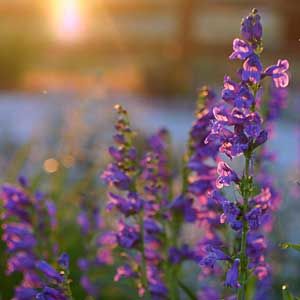
Grasses:
Pine bluegrass Poa scabrella: Fine, dark-green leaves. Forms clumps. Sun to partial shade. Moderate moisture. 3 feet.
Shrubs:
California redbud Cercis orbiculata: Magenta flowers. Heart-shape leaves. Sun. Dry once established. 20 feet.
Desert peach Prunus andersonii: Pink flowers develop into brownish fruit. Sun. Dry. 6 feet.
Big Basin sagebrush Artemisia tridentata:Bluish-gray foliage. Sun. Dry. 9 feet
Wildflowers:
Mountain pride penstemon Penstemon newberryi: Red tubular flowers attract hummingbirds. Sun to partial shade. Dry. 1 foot.
Sagebush penstemon Penstemon speciosus: Brilliant blue flowers. Sun. Dry. 30 inches.
Douglas’ dustymaiden Chaenactis douglasii: Clusters of white flowers attract butterflies. Sun to partial shade. Dry. 1½ feet
Sulfur buckwheat Eriogonum umbellatum: Forms a mound with long-lasting yellow flowers. Sun. Dry. 1 foot
Western columbine Aquilegia formosa: Red and yellow flowers attract swallowtail butterflies. Sun. Moderate moisture. 3 feet.
Rainbow iris Iris hartwegii Baker: Light-yellow flowers have golden or purple veins. Sun to shade. Moist. 1 foot.
Pink alumroot Heuchera rubescens: Sprays of pink flowers. Shade to partial sun. Moist. 3 inches.
Resources:
5. California Grasslands, Chaparral, and Woodland
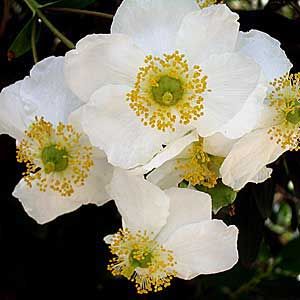
Grasses:
Deergrass Muhlenbergia rigens: Similar to pampas grass but shorter. Plumes 2 feet long. Sun or partial shade. Dry. 4½ feet
Shrubs:
Bush anemone Carpenteria californica: Clusters of scented white flowers in late spring and summer. Sun to shade. Low to moderate water. 6 feet.
Hummingbird trumpet Epilobium canum: Orange-red flowers in fall attract hummingbirds migrating south for winter. Sun to partial shade. Dry. 2 feet.
California lilac Ceanothus sp.: Lilac-type blossoms. Varieties range from groundcovers to tree size. Sun. No summer water. 21 feet.
Western sweetshrub Calycanthus occidentalis: Fragrant flowers spring through summer. Woody fruit capsules. Sun to partial shade. Little to moderate water. 15 feet.
Twinberry honeysuckle Lonicera involucrata: Pairs of yellow flowers draw hummingbirds. Sun or shade. Moist. 10 feet.
Chaparral currant Ribes malvaceum: Showy pink flowers October to March. Leaves smell like peppermint. Sun to partial shade. No summer water. 5 feet.
Wildflowers:
Matilija poppy Romneya coulteri: Large “crepe paper” flowers. Can be invasive. Sun. Dry. 8 feet.
Scarlet monkeyflower Mimulus cardinalis: Blooms most of the year. Attracts hummingbirds. Sun or shade. Moderate water. 2½ feet.
Yellow mariposa lily Calochortus luteus: Bowl-shape yellow flowers 2½ inches wide. Sun to partial shade. No summer water. 1½ feet.
6. Mojave and Sonoran Deserts
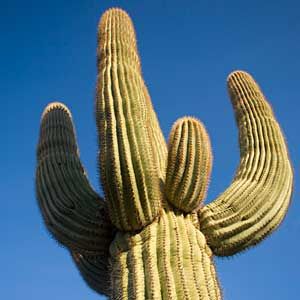
Shrubs:
Quail bush Atriplex lentiformis: Stores salt in its leaves. Draws birds. Sun. Dry. 8 feet.
Fairyduster Calliandra eriophylla: Exotic purple flowers look like bottle brushes. Sun. Dry. 3 feet
Brittlebush Encelia farinosa: Yellow daisy flowers 2-3 inches wide. Sun. Dry. 1 foot.
Ocotillo Fouquieria splendens: Looks dead until rain comes. Red flowers mass on stems in spring and summer. Sun. Dry. 10 feet.
Wildflowers:
Desert marigold Baileya multiradiata: Yellow daisy flowers early spring to mid-summer. Sun. Dry. 2 feet.
Blackfoot daisy Melampodium leucanthum: White daisy flowers March to December. Sun to partial shade. Dry. 12 inches
Firecracker penstamon Penstemon eatonii: Bright red flowers draw hummingbirds. Sun to partial shade. Dry. 2½ feet.
Cacti and succulents:
Saguaro Carnegiea gigantean: A Western symbol, with upward curving arms branching off from a tall, thick stem. Grows about 1 inch per year. Sun. Dry. To 25 feet or more.
Hedgehog cactus Echinocereus engelmannii: Produces brilliant pink flowers February to May. Yellow fruit. Sun. Dry. 1 foot.
Banana yucca Yucca baccata: Flower spike develops edible fruit shaped like a banana. Sun to partial shade. Dry, but some watering is OK. 6 feet.
Resource:
7. Rocky Mountain Forests and Alpine Vegetation
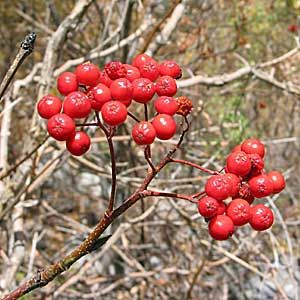
Grasses:
Tufted hairgrass Deschampsia cespitosa: A clump grass. Sun. Moist to moderately dry. 3½ feet.
Shrubs:
Golden Currant Ribes aureum: Flower show resembles forsythia. Edible berries. Sun or partial shade. Dry to moderately moist. 10 feet.
Western mountain ash Sorbus scopulina: Bright orange fruit attracts birds, especially cedar waxwings. Sun to partial shade. Moderate moisture. 12 feet.
Red elderberry Sambucus racemosa: Edible red fruit. Sun to partial shade. Moderate moisture. 18 feet.
Western thimbleberry Rubacer parviflorus: Scattered edible berries. Sun. Moderate moisture. 4 feet.
Wildflowers:
Colorado columbine Aquilegia caerulea: Blue and white flowers. Sun or shade. Moist. 2 feet.
Rocky Mountain iris Iris missouriensis: Purple flowers about 3 inches across. Sun to partial shade. Moist. 1 foot.
Harebell Campanula rotundifolia: Also known as bluebells. Partial sun. Moist. 1 foot.
Nelson’s larkspur Delphinium nelsonii: Blossoms are a brilliant blue-purple. Sun. Dry. 1 foot.
Fringed sage Artemisia frigida: Fragrant, silver-gray leaves. Small yellow flowers. Sun or partial shade. Dry. 8 inches.
Aspen daisy Erigeron speciosus: Blue daisy flowers. Partial sun. Dry to moist soil. 2 feet.
Resources:
Colorado State University Herbarium
8. Central Prairies and Plains
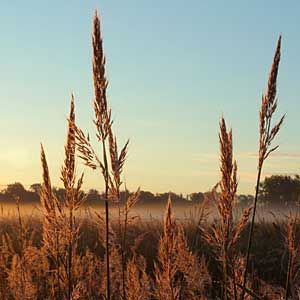
Grasses:
Big bluestem Andropogon gerardii: Showy summer and fall. Sun. Dry. 3 feet.
Buffalo grass Bouteloua dactyloides: Good turf grass. Tolerates clay soil. Sun. Dry. 6 inches.
Indian grass Sorghastrum nutans: Rust-colored seed heads. Sun. Moderate water. 4 feet.
Wildflowers:
Meadow blazing star Liatris pycnostachya: Spikes of purple flowers in late summer. Sun. Moderate water. 4 feet.
Downy phlox Phlox pilosa: Five-petal pink-lavender blossoms in early summer. Sun. Moderately moist to dry soil. 2 feet.
Butterfly weed Asclepias tuberose: Orange-red flowers attract butterflies. Interesting seed pods. Sun. Dry. 2 feet.
Black-eyed Susan Rudbeckia hirta: Yellow flowers form in second year. Partial sun. Dry to moist soil. 2½ feet.
Large-flowered beardtongue Penstemon grandiflorus : Pink to purple flowers in early summer. Sun. Dry to moderately dry soil. 3 feet.
Hoary puccoon Lithospermum canescens: The name refers to the white hairs on leaves. Yellow flowers. Sun. Dry to moderately damp soil. 1½ feet
Aromatic Aster Aster oblongifolius: Sky blue flowers in September. Sun. Moderately dry to medium moisture. 3 feet.
Resource:
University of Minnesota Extension
9. Eastern Deciduous Forests
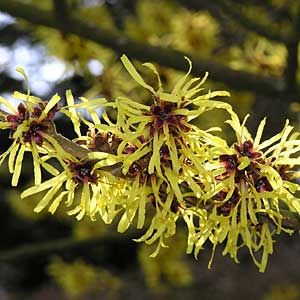
Grasses:
Bottlebrush grass Hystrix patula: Seed heads look like skimpy bottle brushes. Partial sun to light shade. Moist to slightly dry soil. 5 feet.
Shrubs:
Eastern redbud Cercis canadensi: Pink flowers on bare stems, followed by heart-shape leaves. Shade. Little water. 25 feet.
Witch hazel Hamamelis virginiana: Blooms in late winter. Aromatic. Sun or partial shade. Moderate moisture. 20 feet.
Mountain laurel Kalmia latifolia: Blooms in early summer. Evergreen. Partial sun to shade. Wet to dry. 20 feet.
Gray twigged dogwood Cornus racemosa: White flowers and white fruits that birds love. Sun or shade. Moderate moisture. 15 feet.
Wintergreen Gaultheria procumbens: A ground cover with edible red berries. Sun to shade. Dry to moderately wet. 6 inches.
Wildflowers:
Spring beauty Claytonia virginica: For woodland gardens. Blooms early. Partial sun or shade. Moist. 12 inches.
New England aster Symphyotrichum novae-angliae: Purple fall flowers with yellow centers. Great for the back of a garden. Sun to partial shade. Moderate to moist soil. 5 feet.
Wild blue phlox Phlox divaricata: Slightly fragrant spring bloomer. Partial sun to shade. Average to moist soil. 1 foot.
Wild ginger Asarum canadense: Tidy groundcover with curious maroon flowers below leaves. Shade. Moderate moisture. 8 inches.
Blue bead lily Clintonia borealis: Bell-shape flowers develop into shiny blue berries. Shade. Moderate moisture. 1 foot.
Resources:
10. Boreal Forests
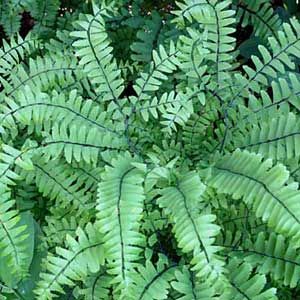
Shrubs:
Highbush cranberry Viburnum opulus var. americanum: Masses of white flowers, followed by edible red fruit. Sun to part shade. Moist. 12 feet.
Highbush blueberry Vaccinium corymbosum: Berries enjoyed by people and birds. Sun. Moist. 6 feet.
Canadian yew Taxus canadensis: Evergreen, provides good cover for birds. Shade to partial shade. Moist soil. 6 feet.
Sweetgale Myrica gale : Dark green, aromatic leaves. Sun. Moist to dry. 4 feet.
Wildflowers:
Marsh marigold Caltha palustris: Showy yellow flowers in early spring. Sun to part shade. Wet to moist soil. 12 inches.
Solomon’s seal Polygonatum pubescens: A lily with gracefully arching stems and bell-shaped flowers. Shade to partial shade. Moist. 12 inches.
New England aster Symphyotrichum novae-angliae: Deep purple flowers in fall. Sun to partial shade. Moist to dry. 24 inches.
Bunchberry Cornus canadensis : Related to dogwood trees, but groundcover height. Shade to partial sun. Moist. 6 inches.
Ferns:
Maidenhair fern Adiantum pedatum: Graceful black stems. Shade to partial sun. Moist. 18 inches.
Marginal wood fern Dryopteris marginalis: Blue-green fronds. Shade to partial sun. Moist to dry. 24 inches.
Resource:
University of Maine Cooperative Extension
11. Coastal Plain Forests
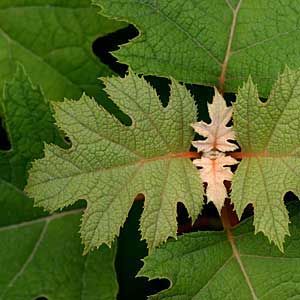
Grasses:
River oats Chasmanthium latifolium: Arching stems hold dangling seed heads. Sun to partial shade. Moist soil. 5 feet.
Shrubs:
Yaupon Holly Ilex vomitoria : Evergreen with long-lasting red berries. Shade. Moderate to moderately damp soil. 12 feet.
Possumhaw Ilex decidua: A deciduous holly. Partial sun to shade. Moderate water. 33 feet.
Oakleaf hydrangea Hydrangea quercifolia: White to rose blossoms in summer. Fall color. Shade. Moderate to moderately wet soil. 12 feet.
Southern wax myrtle Myrica cerifera: Gray-green to yellow-green foliage. Partial sun to shade. Low to moderate water. 10 feet.
Sweet mountain azalea Rhododendron canescens : Pink or purple flowers. Partial sun to shade. Moderate to moderately wet soil. 15 feet.
Coastal sweet pepperbush Clethra alnifolia: Blooms in summer. Very fragrant. Sun to shade. Moderately wet to wet soil. 12 feet.
Wildflowers:
Eastern purple coneflower Echinacea purpurea: Pink or purple flowers all summer. Sun. Moderate water. 4 feet.
Eastern bluestar Amsonia tabernaemontana: Blue star-shaped flowers in spring attract mourning cloak butterflies. Sun to partial shade. Moderately damp to wet. 3 feet.
Appalachian blazing star Liatris squarrulosa: Forms tight heads of rose-purple flowers in fall. Sun. Moderately damp to dry soil. 2½ feet.
12. Tropical
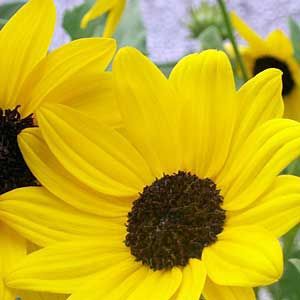
Shrubs:
Limber caper Capparis flexuosa: A viny shrub related to Italian capers. Produces fragrant, spidery flowers and beanlike seed pods. 12-25 ft. Full sun to full shade. Dry.
Wildflowers:
Beach sunflower Helianthus debilis: Draws butterflies to yellow sunflowers up to 3 inches wide. Grows 3-4 ft. tall. Full sun. Dry.
Resource:
